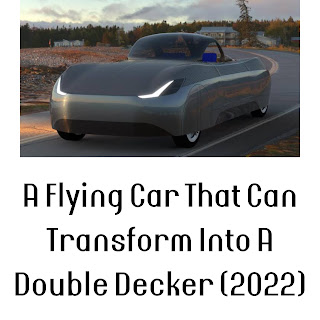At a launch event at Draper University in San Mateo, California, a startup announced plans to take off a flying car.
Aleph describes the Model A, an electric car still in development, as the first true flying car. The car looks like a sleek electric car, but taking off vertically he hopes it can fly 110 km (68 km).
The company wants to compete in a market occupied by far more advanced competitors already flying and driving, such as AirCar and his Pal-V gyrocopter.
The company wants to compete in a market occupied by far more advanced competitors already flying and driving, such as AirCar and his Pal-V gyrocopter.
But Alef CEO and co-founder Jim Dukhovny argues that most existing vehicles aren't pure flying cars in his opinion.
"A flying car should be a car, which means it should be able to drive on normal roads and park in normal parking lots. It should also be able to take off vertically," he told the BBC.
"What problem would you solve if you needed an airport to take off from? And why is it a flying car?"
"A flying car should be a car, which means it should be able to drive on normal roads and park in normal parking lots. It should also be able to take off vertically," he told the BBC.
"What problem would you solve if you needed an airport to take off from? And why is it a flying car?"
Flip To Fly
The Model A's car-like exterior is meshed at the top, allowing air to flow to eight propellers inside the body to provide lift.
But it takes an exorbitant amount of power to fly far with these alone, without the help of wings.
Aleph's proposal for a solution is revolutionary. On long flights, Model A transforms into his double decker.
Aleph's proposal for a solution is revolutionary. On long flights, Model A transforms into his double decker.
After vertical take-off, Model A turns sideways and the two-seater cockpit rotates so the driver remains forward, making the vehicle a double-decker vehicle with the long sides forming the upper and lower wings.
The classic biplane geometry of two overlapping wings is better understood in Model A by imagining that the net between the fixed sides has been removed. Alef also created a video visualizing the transition.
The classic biplane geometry of two overlapping wings is better understood in Model A by imagining that the net between the fixed sides has been removed. Alef also created a video visualizing the transition.
Forbes observed that its flight method is similar to the Opener Blackfly, an existing vertical take-off electric aircraft.
Great idea, but is it practical?
Combining flying and driving adds weight, and electricity means batteries are also heavy.
Great idea, but is it practical?
Combining flying and driving adds weight, and electricity means batteries are also heavy.
"This design is just on the edge of what physics and technology can do, and that's what you'd expect," says Professor Steve Wright, an aeronautical engineer at the University of the West of England. It can also cause significant drag, he adds.
Alef says that since 2018 he has transitioned to biplanes in "scaled flights." There are also larger prototypes capable of vertical flight, but they still don't quite match the sleek look of the company's mockups and concepts. I warn you that it's easy to underestimate.
Engineering hurdles are just an obstacle to building highways in a sky full of flying cars.
Regulations and certifications for flying cars, like those for other planes, can be rigorous, time-consuming and expensive.
A pilot's license is required to fly a biplane, even one that can be driven on public roads. Dukhovny believes a drone pilot license may be sufficient for vertical flight over obstacles and short jumps at low altitudes.
Authorities may also impose strict rules on where vehicles can be flown.
Regulations and certifications for flying cars, like those for other planes, can be rigorous, time-consuming and expensive.
A pilot's license is required to fly a biplane, even one that can be driven on public roads. Dukhovny believes a drone pilot license may be sufficient for vertical flight over obstacles and short jumps at low altitudes.
Authorities may also impose strict rules on where vehicles can be flown.
"No roads to go"
For these and other reasons, Professor Wright believes the future of flying cars will not consist of a single consumer-owned, driven, and flown vehicle.
In the movie Back to the Future, character Doc Brown's DeLorean fusion power car veers off the road and crashes into the air. No way, this is a real shame, I want a flying DeLorean more than anyone else,” says Professor Wright.
In the movie Back to the Future, character Doc Brown's DeLorean fusion power car veers off the road and crashes into the air. No way, this is a real shame, I want a flying DeLorean more than anyone else,” says Professor Wright.
In fact, Professor Wright argues that traveling in a flying car is like hiring a taxi.
“I pull out my phone and the robot car stops and takes me to an area the size of a small park. Chinese company Xpeng recently gave its first public demonstration of its X2 vehicle in Dubai. When asked who will pay for the Model A's initial $300,000 (£266,000) price tag, he said "early adopters."
People have been waiting for flying cars, he says, for 100 years. Aleph's ambitious goal is to start selling vehicles in 2025.
“I pull out my phone and the robot car stops and takes me to an area the size of a small park. Chinese company Xpeng recently gave its first public demonstration of its X2 vehicle in Dubai. When asked who will pay for the Model A's initial $300,000 (£266,000) price tag, he said "early adopters."
People have been waiting for flying cars, he says, for 100 years. Aleph's ambitious goal is to start selling vehicles in 2025.








0 Comments